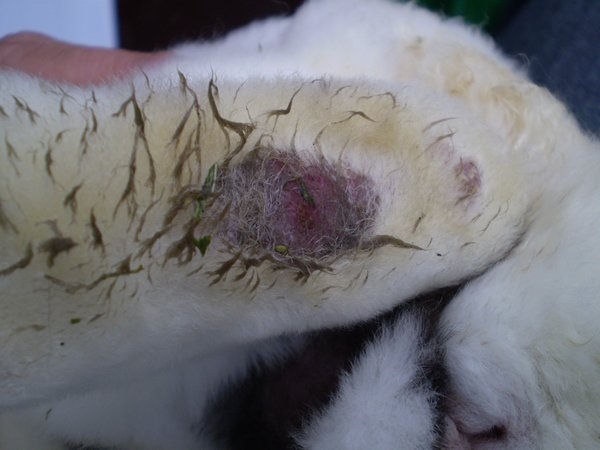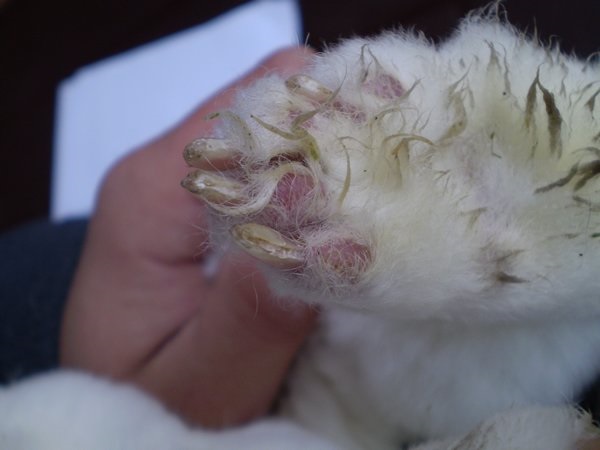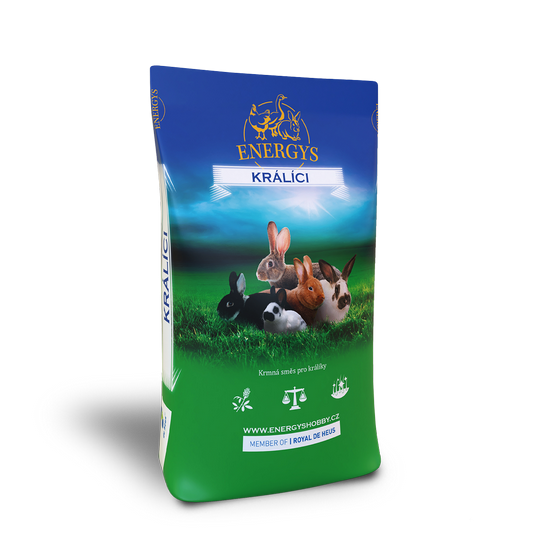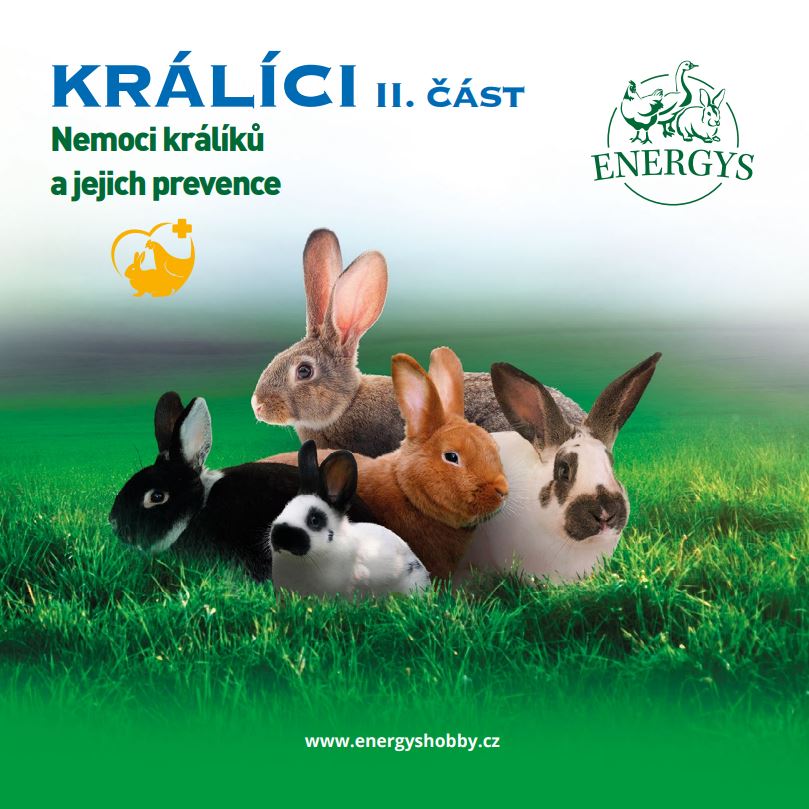Pressure sores on rabbit’s legs – an endless problem?
The contact surface on rabbits‘ feet in hairy, which is rather unusual among mammals. Cases of the so-called pressure sores occurring on rabbits‘ feet have been documented by breeders, especially those who breed rabbits for competitions. Pressure sores may disturb the animals‘ movement and when left untreated may pose major health problems.
What does it look like?
Pressure sores on legs may appear at various intensity. At the first stage, they may not be clearly visible and may remain hidden under fur. This can be considered the critical stage, as these symptoms may escape the breeder’s attention. During the subsequent stage, the fur starts to thin and fall out, the skin hardens and reddens and the contact surfaces of feet become painful. During advanced stages of the disease, rabbits often do not move much. While hind legs are affected more frequently, affected front legs are not an exceptional occurrence, especially recently.


The development of the so-called chronic pododermatitis may be influenced by many genetic and external factors that must be considered in the treatment of pressure sores. The most important factors include:
- Breed
Especially heavier rabbit breeds are more susceptible to pressure sore symptoms. This also affects short-hair (rex) breeds. Solid, rather than grid floor is recommended for these breeds for this reason.
- Condition of animals
Pressure sores are detected more frequently in obese rabbits with unsuitable composition of the feeding dose or an inadequate feeding technique (overfeeding).
- Age of animals
Pressure sores are observed in practice in particular in adult and older rabbits. Cases of clinical symptoms in immature animals are rare.
- Technological character of floors
The occurrence of pressure sores is traditional attributed to the technological floor design, with grid floors being considered unsuitable in this regard. However, this may not apply in all cases. Grid floors undoubtedly ensure a higher standard of hygiene. Grids may be made of various materials – mostly metal or plastics. The quality (hardness) and shape (surface) of the material plays a major role especially in plastic grids, also with regard to potential undesirable chewing by rabbits. Installation of a protective plastic underlay is recommended in the case of metal grids to cover the metal wires and eliminate or reduce the occurrence of pressure sores.
- Moisture content and temperature of substrate
Undesirable increased moisture and temperature of the bedding material significantly increases the risk of pressure sores occurring and the risk of their secondary infection. Cleaning pens more frequently is advised especially during summer months to ensure relatively dry bedding material for rabbits.
- Condition of claws
The length and the condition of claws is a relatively infrequently discussed topic that influences the occurrence of pressure sores. Uncut, long claws misshapen rabbit’s toes. Weight is then distributed incorrectly on legs, leading to painful walking (especially in the case of obese animals) and an increased risk of pressure sores occurring or modulating.
- Individual traits of animals
An animal’s individual traits may also be considered a major aspect. Several cases have been observed in practice, where several rabbits – siblings from a single litter exhibited symptoms of pressure sores despite being kept in the same technological system with similar feeding.
Therefore, not only bedding and feeding, but also consistent selection of animals to be used for breeding is important in this regard.
Související články
10. dubna 2024
Zveřejnil: Ing. Lucie Humeni
Chov zakrslých králíků jako domácích mazlíčků získává stále více příznivců. Nevyžaduje velké množství prostoru a je ideální pro lidi, kteří žijí v menších domácnostech nebo bytech. Zakrslí králíci jsou také velmi přátelští, takže se není čemu divit, že si je lidé vybírají pro tento účel čím dál častěji. Stejně jako u všech zvířat je i…
30. srpna 2022
Zveřejnil: Tým specialistů na chov králíků De Heus
V tomto článku se budeme věnovat několika nemocem králíků – ušnímu svrabu, Tyzzerově chorobě a tepelnému stresu.
24. srpna 2022
Zveřejnil: Tým specialistů na chov králíků De Heus
V tomto článku se podíváme na dvě nemoci – E.coli a enterokolitida
2. srpna 2022
Zveřejnil: Tým specialistů na chov králíků De Heus
V tomto článku se podíváme na dvě časté nemoci králíků myxomatózu a infekční rýmu.
13. července 2022
Zveřejnil: Tým specialistů na chov králíků De Heus
V následujícím článku se budeme věnovat moru králíků – RHD nebo VHD (virovému hemoragickému onemocnění králíků).
Související produkty

KRÁLÍK ZAKRSLÝ
Kompletní granulované krmivo pro zakrslé králíky s vysokou stravitelností. Obsahuje vysoký podíl vlákniny (vysoký obsah vojtěšky a travních úsušků) a snížený obsah cukru a škrobu. Obsahuje lněné semínko, které má pozitivní vliv na kvalitu srsti. Vhodné pro každodenní krmení. Doporučujeme zajistit králíkům nezávadnou čerstvou vodu a seno.

KRÁLÍK CHAMPION
Krmivo pro výstavní králíky, neobsahuje kokcidiostatika. Unikátní složení významně podporuje kvalitu a růst srsti. Podávejte při přelínávání a minimálně 2 měsíce před zahájením výstavní sezóny.

KRÁLÍK GOLD FORTE
Prémiová krmná směs ideální svým složením pro březí a kojící samice. Pro intenzivní výkrm králíků do období min. 5 dnů před porážkou. Podporuje rychlý růst, zmasilost a výborný zdravotní stav. Obsahuje kokcidiostatikum, čímž snižuje riziko úmrtnosti.

KRÁLÍK KLASIK FORTE
Určená pro výkrm králíků až do doby min. 5 dní před porážkou. Vhodné pro dosažení vysoké zmasilosti a výborného zdravotního stavu. Díky obsahu kokcidiostatika snižuje mortalitu zvířat.

KRÁLÍK KLASIK
Pro celou dobu výkrmu králíků. Podporuje vysokou zmasilost a vynikající chuťové vlastnosti králičího masa. Bez kokcidiostatik.

KRÁLÍK START
Pro mladé králíky od začátku příjmu krmiva do 4–6 týdnů po odstavu. Krmivo pomáhá významně snížit úhyn v období okolo odstavu. Obsahuje zvýšený podíl vlákniny a méně škrobů. Neobsahuje kokcidiostatikum.

